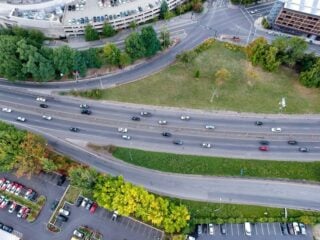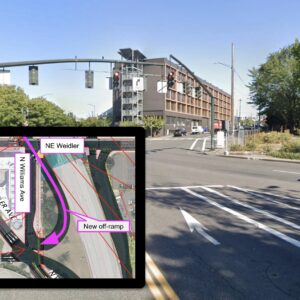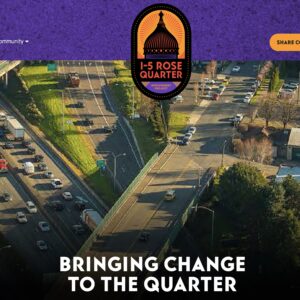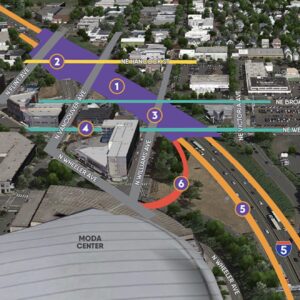
(Photo: Emily Guise)
The Audubon Society of Portland and OPAL Environmental Justice Oregon want to make sure the Oregon Department of Transportation doesn’t short-change the environment as they plan to add and expand lanes on Interstate 5 through the Rose Quarter.
A Freedom of Information Act (FOIA) request was formally made today by the Crag Law Center on behalf of both organizations.
According to the letter, Audubon Society and OPAL want to see, “all documents relating to the question of whether FHWA [Federal Highway Administration] and ODOT intend to prepare initially an environmental assessment (“EA”) as opposed to a more thorough environmental impact statement (“EIS”) for the I-5 Rose Quarter Improvement Project. Documents subject to this request include, without limitation, electronic mail, text messages, web-based content, all writings, letters, memoranda, notes wherever they are found, summaries, working papers, schedules, draft documents, correspondence, documentation of meetings, minutes from meetings, data, graphs, charts, photos, and/or maps.”
Advertisement
The U.S. Environmental Protection Agency requires EAs and EISs as part of their National Environmental Policy Act (NEPA) review process. “The EA determines whether or not a federal action has the potential to cause significant environmental effects,” states the EPA’s website. An EIS is needed when a project is, “Determined to significantly affect the quality of the human environment.” At issue here the fact that an EA requires much less work than a full-blown EIS. In the words of the EPA: “The regulatory requirements for an EIS are more detailed and rigorous than the requirements for an EA.”
According to Chris Winter, the Crag Law Center lawyer who filed the request, his clients are, “Seeking to better understand the environmental analysis regarding the I-5 project and to explain the scope and nature of the environmental review to be conducted.” “Both organizations have been leading voices for protection of air and water quality in the Portland metro region,” Winter writes in the letter, “and provide education to their members and the public about threats to the natural resources that could be impacted by this project.”
OPAL and Audubon have both signed onto a list of Portland-area organizations hosted by No More Freeways PDX, “expressing concern for the proposed expansion of the Rose Quarter Freeway.” The project has garnered intense opposition due to the agency’s claims that it will relieve traffic congestion and improve safety — even though no highway expansion has ever reduced congestion and the safety concerns have proven to be way overblown.
The FHWA is expected to respond to this request within 20 working days.
Stay tuned this coming Monday (3/26) when both organizations are set to make a public statement about the request.
— Jonathan Maus: (503) 706-8804, @jonathan_maus on Twitter and jonathan@bikeportland.org
Never miss a story. Sign-up for the daily BP Headlines email.
BikePortland needs your support.





Thanks for reading.
BikePortland has served this community with independent community journalism since 2005. We rely on subscriptions from readers like you to survive. Your financial support is vital in keeping this valuable resource alive and well.
Please subscribe today to strengthen and expand our work.
great news!
Bravo OPAL and ASP !
If that request is granted, it’ll be interesting to see what they find, and what the powers that be don’t want the public to know about. Not to mention their mindset about ped/bike access in the area, especially with the proposal for a new ped/bike bridge in that part of town.
When they calculate the environmental effects, can we include the difference between the boondoggle and what we’d expect if we spent the money on something actually in accordance with our climate goals?
Except for the murder of small children, the project will go on as there are too many monied interests who will benefit spurred on by the Oregonian. Heck, in Colorado, they are mowing down minority neighborhoods in the name of progress. Almost like it’s 1950 all over again.
I’m an unapologetic and proud interstate/high-speed-arterial NIMBY.
I’m still hoping the Big One hits sooner rather than later. A 20% chance by 2035 isn’t good enough.
not sure this will relieve any congestion in that area..since is bottle necks even worse (south bound I5) on the other side of Marquam Bridge…
Why not just make all I5 Traffic go thru downtown on the 405?
Big thanks to OPAL, CRAG and Audubon Society. Each are sticking their necks out to challenge this project, and each should be celebrated for helping us with the campaign.
I hope they find some spotted owl nests. That will set the freeway-heads back on their heels.
It doesn’t matter if ODOT/FHWA initially start an EA or an EIS because an EA will lead to an EIS if there significantly environmental impacts found through the course of analysis. The only real factor that is pushing this project into an EA is the “substantial controversy on environmental grounds” (CFR Sec. 771.117(b)). Otherwise, this project could fit within a Documented Categorical Exclusion, likely this one: 771.117(d)(1) Modernization of a highway by resurfacing, restoration, rehabilitation, reconstruction, adding shoulders, or adding auxiliary lanes (e.g., parking, weaving, turning, climbing). In most parts of the country, this project would be considered a nothing burger.
Exactamundo!
There are not any clearly identified significant impacts to warrant an EIS at this stage. However, due to the public involvement and concern, the EA option was utilized in this case.